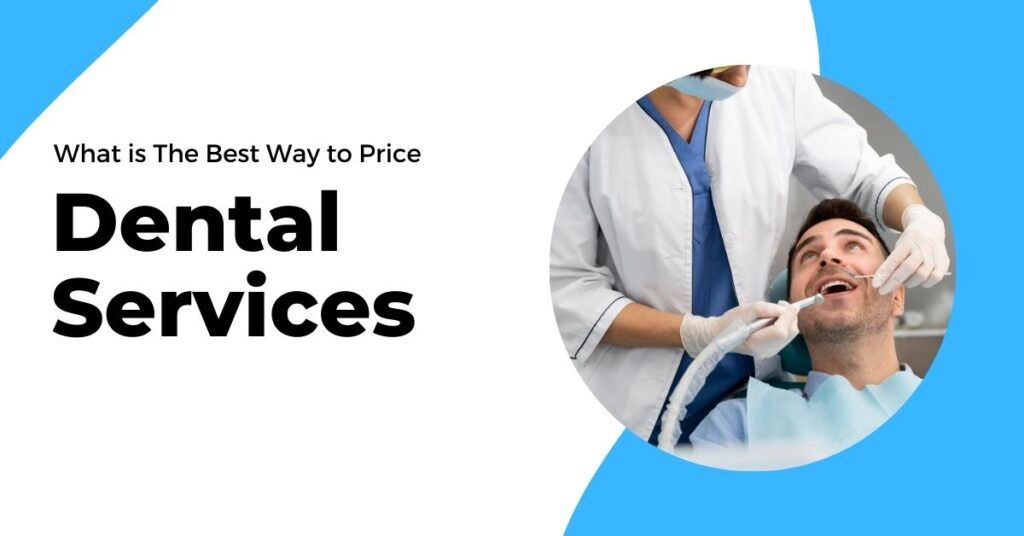Pricing dental services demands a strategic approach tailored to the unique challenges and opportunities in the rapidly transforming healthcare environment. The best way to price dental services in 2023 is through some effective strategies like understanding important factors, considering quality, affordability, etc.
This blog post aims to shed light on the best way to price dental services in 2023 in this current landscape, emphasizing clarity, transparency, and adaptability.
Understanding the Factors Influencing Pricing
Setting the right price for dental services or dental worthiness requires a nuanced understanding of various factors that collectively influence the financial health of a dental practice. These factors not only vary from one geographic location to another but also evolve over time. Here’s a closer look at the key elements that dental professionals must consider when determining the cost of their services:
1. Overhead Costs:
- Rental or lease expenses, utilities, and maintenance costs contribute to the overhead that directly impacts pricing decisions.
- Staff salaries and benefits are crucial components, reflecting the quality of service and expertise within the practice.
2. Equipment and Technology Expenses:
- The integration of advanced dental technology comes with its own set of costs.
- Investments in cutting-edge equipment should be factored into pricing strategies to ensure long-term sustainability.
3. Regulatory Compliance and Licensing Fees:
- Dental practices must adhere to strict regulatory standards, incurring compliance and licensing fees.
- Staying abreast of legal requirements is vital for avoiding penalties and maintaining a trustworthy reputation.
4. Market Demand and Competition:
- The level of demand for dental services in a particular area influences pricing.
- Analyzing competitors’ pricing models can help in positioning a practice within the market. If you find it difficult to analyze the market demand of your dental practice, you can surely collaborate with Smile SEO for expert opinion.
5. Geographic Location:
- The cost of living and economic factors in a specific location can impact the pricing of dental services.
- Understanding regional variations is essential for tailoring pricing strategies to local demographics.
6. Target Patient Demographics:
- The demographic profile of the target patient population influences pricing decisions.
- Customizing services and pricing to meet the needs of specific patient groups enhances competitiveness.
As we delve deeper into this exploration of dental service pricing, it becomes evident that a comprehensive understanding of these factors is the cornerstone of effective pricing strategies in 2023. Dental professionals must navigate this intricate web of considerations to strike a balance between delivering quality care and maintaining a financially viable practice.
Read more: How to Start a Dental Clinic Business

Common Dental Procedures and Pricing
1. Dental Cleaning (€50 to €100)
Dental cleanings, also known as prophylaxis, involve the removal of plaque and tartar from the teeth. The cost of a dental cleaning can vary based on the extent of cleaning needed and the presence of conditions like gingivitis. Routine cleanings typically cost around €50 to €100.
2. Cavity Filling (€70 to €150)
When a tooth develops a cavity due to decay, a dentist removes the decayed portion and fills the space with a dental filling. The cost of a cavity filling depends on the type of filling material used (amalgam, composite, or ceramic) and the size of the cavity. Simple fillings may range from €70 to €150.
3. Root Canal Treatment (€300 to €700)
Root canal treatment is necessary when the pulp (the innermost part of the tooth) becomes infected or damaged. The procedure involves removing the infected pulp, cleaning the canal, and sealing it. The cost varies based on the tooth’s location and complexity, ranging from €300 to €700.
4. Dental Crowns (€400 to €900)
Dental crowns are used to restore and strengthen damaged teeth. Crowns can be made of various materials, including metal, porcelain-fused-to-metal, and all-ceramic. The cost depends on the material used, the technology employed, and the location of the dental practice. Dental crown prices typically range from €400 to €900.
5. Dental Implants (€1,500 and €3,000)
Dental implants are a permanent solution for replacing missing teeth. The process involves surgically placing a titanium implant into the jawbone, which acts as an artificial tooth root. The cost of dental implants can vary based on the number of implants needed, the complexity of the procedure, and additional components like abutments and crowns. On average, a single dental implant may cost between €1,500 and €3,000.
6. Teeth Whitening (€150 to €500)
Professional teeth whitening is a cosmetic procedure aimed at lightening the color of the teeth. The cost depends on the method used, such as in-office bleaching or take-home kits, and the number of sessions required to achieve the desired results. Teeth whitening costs typically range from €150 to €500.
7. Custom-Made Mouth Guard (€150 and €500)
Custom-made mouth guards are often recommended for individuals who grind their teeth at night or participate in contact sports. The cost of a custom mouth guard can vary based on the materials used and the complexity of the design. On average, expect to pay between €150 and €500 for a professionally crafted custom mouth guard.
8. Dentures (€500 and €2500)
Dentures are removable prosthetic devices used to replace missing teeth. The cost of dentures depends on factors such as the type of denture (partial or full), the materials used, and the complexity of the fitting process. Basic, removable partial dentures may start around €300, while complete sets of dentures can range from €500 to €2,500 or more, depending on the quality and materials.
9. Dental Bridges (€500 and €1500)
Dental bridges are used to replace missing teeth by anchoring artificial teeth (pontics) to adjacent natural teeth or dental implants. The cost of dental bridges varies based on the number of pontics, the materials used, and the complexity of the procedure. On average, expect to pay between €500 and €1,500 per pontic, making the total cost for a bridge range from €1,000 to €3,000 or more.
10. Orthodontic Treatments (Braces or Invisalign) (€2000 and €7000)
Orthodontic treatments aim to correct misaligned teeth and improve the bite. The cost of braces or Invisalign can vary significantly. Traditional braces may range from €1,500 to €5,000 or more, depending on the duration of treatment and complexity. Invisalign, an alternative clear aligner system, may cost between €2,000 and €7,000.
11. Gum Disease Treatment (Scaling and Root Planing) (€100 and €300)
Scaling and root planing is a deep cleaning procedure used to treat gum disease. The cost depends on the severity of the condition and the number of teeth involved. The average cost for this treatment can range from €100 to €300 per quadrant (quarter of the mouth).
12. Wisdom Teeth Extraction (€225 and €600)
The extraction of impacted wisdom teeth can vary in complexity, affecting the overall cost. Simple extractions may range from €100 to €300 per tooth, while surgical extractions (for impacted wisdom teeth) can cost between €225 and €600 or more per tooth.
13. TMJ (Temporomandibular Joint) Disorder Treatment (€50 and €200)
Treatment for TMJ disorders may involve various approaches, including physical therapy, splints, or medications. Costs can vary, with an initial consultation ranging from €50 to €200, and ongoing treatment costs depending on the recommended therapy.
Current Trends To Determine The Best Way to Price Dental Services in 2023
In 2023, the landscape of dental service pricing has evolved, reflecting changing patient expectations and industry dynamics. Dentists are adopting innovative approaches to stay competitive and provide value to their patients. Understanding these trends can be the best way to price dental services in 2023.
Here are some current trends in dental procedures cost list:
1. Value-Based Pricing Models:
- Dentists are increasingly moving towards value-based pricing, focusing on the outcomes and overall value delivered to the patient rather than just the services provided.
- This approach aligns with the emphasis on patient-centered care, where the quality of service and patient satisfaction play a crucial role in determining prices. When you set a value based pricing system, you can attract more patients to your dental business.
2. Subscription-Based Dental Care Plans:
- Many dental practices are introducing subscription-based plans, offering patients a comprehensive package for preventive and routine care at a fixed monthly or yearly fee.
- These plans often include regular check-ups, cleanings, and discounts on additional services, providing patients with predictable costs and encouraging regular dental visits.
3. Bundled Services and Package Deals:
- Dentists are bundling related services to provide patients with cost-effective packages. THis can be one of the best way to price dental services in 2023.
- Bundled services may include comprehensive oral health assessments, teeth whitening, or other cosmetic procedures, allowing patients to access multiple services at a discounted rate.
4. Transparent Pricing and Patient Education:
- Transparency in pricing has become a key focus, which can be one of the best way to price dental services in 2023. In this way, dental practices provide clear and easily understandable information about the cost of services.
- Patient education is intertwined with transparent pricing, ensuring that individuals understand the value they receive and the factors influencing the overall cost of their dental care.
5. Digital Platforms as one of the best way to price dental services in 2023:
- Patients now have access to digital platforms that facilitate price comparison and reviews for dental services.
- Dental practices are adapting by showcasing their pricing structures online, responding to patient reviews, and actively engaging with potential patients through social media and review platforms.

Importance of Transparency to determine the best way to price dental services in 2023
Transparency in pricing is more than just a buzzword in the dental industry; it’s a fundamental element that can shape the patient experience and build trust between practitioners and those seeking dental care. Here’s why transparency in pricing is of paramount importance:
1. Building Trust with Patients:
- Transparent pricing builds trust by eliminating hidden costs and surprises. Patients appreciate knowing what to expect financially, fostering a sense of transparency and honesty in their interactions with the dental practice.
2. Enhancing Patient Experience:
- Clarity in pricing contributes to the best way to price dental services in 2023. When patients are well-informed about the costs associated with their care, they can make confident decisions and plan for their dental expenses.
3. Reducing Patient Anxiety:
- Transparent pricing reduces anxiety related to financial concerns. Patients are more likely to follow through with recommended treatments when they have a clear understanding of the financial implications, leading to better overall oral health outcomes.
4. Facilitating Informed Decision-Making:
- Patients are increasingly taking an active role in their healthcare decisions. Transparent pricing empowers them to make informed choices based on their budget, preferences, and the perceived value of the dental services offered.
5. Competitive Advantage:
- Dental practices that prioritize transparency gain a competitive advantage. In an era where patients have access to a wealth of information online, those practices that openly communicate pricing details are more likely to attract and retain patients.
In conclusion, the importance of transparent pricing extends beyond mere financial transactions; it shapes the overall patient-provider relationship and contributes to the long-term success of dental practices in a dynamic healthcare landscape.

Strategies to Find Out The Best Way to Price Dental Services in 2023
In a dynamic healthcare landscape, pricing your dental services competitively is crucial for the success of your practice. Consider implementing the following strategies to ensure your pricing aligns with market demands and patient expectations:
1. Conduct a Thorough Market Analysis:
- Regularly assess the pricing structures of local competitors.
- Identify the range of services they offer and their corresponding prices.
- Analyze patient reviews to understand the perceived value of services.
2. Identify Unique Value Propositions:
- Determine what sets your dental practice apart from others.
- Highlight unique services, advanced technology, or exceptional patient care.
- Use these differentiators to justify premium pricing when applicable.
3. Adjust Prices Based on Patient Feedback:
- Gather feedback through surveys, reviews, and direct communication.
- Be responsive to patient concerns and adjust pricing structures accordingly.
- Demonstrate a commitment to patient satisfaction and value for money.
4. Utilize Technology for Efficient Pricing Strategies:
- Invest in dental software that assists in cost management and pricing optimization.
- Leverage data analytics to understand the profitability of different services.
- Implement online appointment, billing systems and other dental technology for streamlined processes.
5. Regularly Review and Update Pricing Models:
- Stay adaptable to changes in the market and industry standards to determine the best way to price dental services in 2023.
- Periodically review and update your pricing models based on cost fluctuations and emerging trends.
- Communicate changes transparently to patients to maintain trust.

Balancing Affordability and Quality as One of The Best Way to Price Dental Services in 2023
In the ever-evolving landscape of dental services, achieving a delicate equilibrium between affordability and quality is paramount for the success of any dental practice. Striking this balance ensures that patients receive the best possible care without compromising the financial viability of the practice.
1. Understanding Patient Expectations
- Acknowledge that patients today are increasingly discerning and value-conscious.
- Conduct surveys or feedback sessions to gauge patient expectations regarding service quality and pricing.
2. Cost-Effective Operational Practices as one of the best way to price dental services in 2023.
- Explore ways to streamline operational processes to reduce overhead costs.
- Implement efficient inventory management and staffing strategies to optimize resources.
3. Investing in Preventive Care
- Emphasize the importance of preventive dental care to patients.
- Develop pricing models that incentivize regular check-ups and early intervention, potentially saving patients money in the long run.
4. Flexible Payment Options
- Offer flexible payment plans or financing options to make quality dental care more accessible.
- Clearly communicate these options to patients during consultations and on your website.
5. Educating Patients on Value
- Develop educational materials that highlight the long-term benefits of investing in quality dental services.
- Illustrate how preventive measures can lead to fewer complications and ultimately lower overall costs for patients.
Conclusion
In conclusion, the landscape of dental service pricing in 2023 is dynamic and multifaceted. As dental professionals navigate the complexities of the healthcare market, adopting effective pricing strategies becomes crucial to determine the best way to price dental services in 2023. You need to adapt,balance and be transparent about the market trends. Have you implemented any unique strategies in your practice? Share your experiences and learn from others in the community. If you have more questions, feel free to visit Smile SEO for a tailored suggestion.